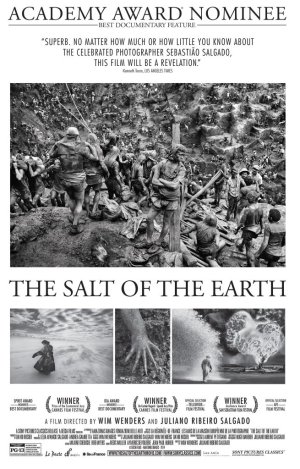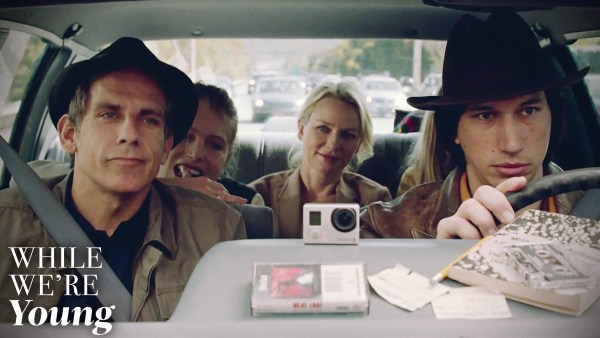WHILE WE’RE YOUNG (2014, directed by Noah Baumbach, 97 minutes, U.S.)
THE SALT OF THE EARTH (2014, directed by Wim Wender & Juliano Ribeiro Salgado, 110 minutes, Germany)
 BY DAN BUSKIRK FILM CRITIC I’ve “liked” or “loved” all of Noah Baumbach’s directorial work up to now which makes his latest While We’re Young feel like a sad departure, the point where a filmmaker gives in to convention at the same spots where previous works like The Squid & the Whale and Margot at the Wedding once defied it. Baumbach has created quite a catalog of disgruntled square pegs across six films and whereas in those films he always allowed them a chance to squirm free of expectations, in While We’re Young he is determined to hammer them into round holes. With 2006’s Greenberg, Baumbach took Ben Stiller agitated shtick and gave it some real soul. With While We’re Young, Stiller seems to have brought Baumbach to his side to make a Ben Stiller film. You know, something that people who really loved Meet the Parents would enjoy.
BY DAN BUSKIRK FILM CRITIC I’ve “liked” or “loved” all of Noah Baumbach’s directorial work up to now which makes his latest While We’re Young feel like a sad departure, the point where a filmmaker gives in to convention at the same spots where previous works like The Squid & the Whale and Margot at the Wedding once defied it. Baumbach has created quite a catalog of disgruntled square pegs across six films and whereas in those films he always allowed them a chance to squirm free of expectations, in While We’re Young he is determined to hammer them into round holes. With 2006’s Greenberg, Baumbach took Ben Stiller agitated shtick and gave it some real soul. With While We’re Young, Stiller seems to have brought Baumbach to his side to make a Ben Stiller film. You know, something that people who really loved Meet the Parents would enjoy.
Stiller and Naomi Watts play a married couple who work in documentary film. Actually Watts works for her father, played by Charles Grodin as a Maysles-type doc film legend. Stiller (more troll-like than ever) on the other hand has spent a decade trying to follow-up his well-regarded debut and is obviously floundering with a film whose premise even he can’t describe. Although the couple has had fertility problems, their infant-coddling friends are a tone-deaf version of the “why don’t you have kids?”-type. Just before the middle aged blahs swallow them whole, Stiller meets a young couple in the film class he teaches, played by Amanda Seyfried and Adam Driver of HBO’s Girls. Stiller (and to a slightly less extent Watts) are dazzled by the youthful pair and before you know it they’re eliciting snortles by refusing to act their boring age.
Admittedly, as Stiller vehicles go, While We’re Young is sturdy enough, it has a comic timing and zips right along. In comparison to Baumbach’s more subtle comedies, it’s a disaster. In the past Baumbach has been a master at painting flawed, complicated characters who stubbornly remain human and likable. With While We’re Young, Baumbach works more broadly in a way that has left us with characters that are condescendingly cartoonish. Meeting the adorable 20’s couple instantly unmoors Watts and Stiller in a way that reminded me of The Brady Bunch, as in one of those episodes where an off-handed comment makes a Brady talk in an accent or wear a wig for a couple days. And then, a lesson is learned. Witnessing the insecurity behind Stiller and Watts’ morphing personalities is so grotesque it is hard to get on board and root for their characters.
There is a odd conservative conformity lingering at the edges of the premise as well, where just a particular cultural interest or even an unassuming little hat can draw disdain and alarm, and can actually get you thrown off the guest list of your best friend’s party. I thought we were living in a world where identity and social possibilities were somewhat flexible but Baumbach’s New York seems nearly as constrained as Victorian England. It’s also interesting to see generations reduced to consumerist habits, someone in their 20s is a used vinyl collection, someone in their 40s is, “Hey Honey, have you seen my Wilco CD?”
Stiller’s character admit to his younger bro that his life has devolved into two emotional settings: wistful and disdainful. That’s where Baumbach’s film lingers, too, his wistfulness for the twenties is made beautiful with Seyfried and Driver (giving pretty much the same performance he gives in Girls, which is still pretty appealing) and his disdain for Stiller’s static life is potent. An ending that pushes the leads towards parenthood seems to negate whatever point Baumbach’s script was strenuously trying to get across. There are scenes early in the film when Stiller looks at his amateurish, ponderous documentary and you think “He really can’t see how bad this is?” But by the time Stiller roller blades through the climax you’re saying, “Baumbach: Can’t you see how bad this is?”
– – – – – – – – – – – – – – – – – –
Wim Wenders The Salt of the Earth is really a museum show posing as a feature film. It’s a wonderful introduction to Brazilian photographer Sebastião Salgado’s work, whose images have contributed to social activism worldwide. His photos have been exhibited in museums around the world but seeing his steely black and white evocative work blown up to movie screen size might be the ultimate way to view his stunning images.
I remember first being introduced to Salgado’s work from a Hellacious picture of thousands of men working in a  gold mine that graced the cover of Jerry Harrison’s 1988 LP, Casual Gods. These photos of men laboring like ants is what first drew Wenders’ interest as well, seeking out Salgado and ultimately co-directing a feature on Salgado with his son, Juliano Ribeiro Salgado. At 70, Salgado is still patiently trudging to some of the world’s most isolated corners to take photos that few would dare and Wender and Salgado’s son struggle to keep up as they literally roll up the beach on a pack of wild walruses and interact with South American mountain tribes busily shooting primates out of the trees with arrows.
gold mine that graced the cover of Jerry Harrison’s 1988 LP, Casual Gods. These photos of men laboring like ants is what first drew Wenders’ interest as well, seeking out Salgado and ultimately co-directing a feature on Salgado with his son, Juliano Ribeiro Salgado. At 70, Salgado is still patiently trudging to some of the world’s most isolated corners to take photos that few would dare and Wender and Salgado’s son struggle to keep up as they literally roll up the beach on a pack of wild walruses and interact with South American mountain tribes busily shooting primates out of the trees with arrows.
Along the way Salgado tells the story of his journey from being a privileged Brazilian rancher’s son, to becoming an economist than finally a nature photographer, exploring South America after taking exile from Brazil in 1969. Salgado began to increasingly photograph third world workers and their conditions. This is added a political context to Salgado’s work that gives the film a sad urgency.
Rescuing the film from the “disaster porn” that documents so much of the man’s destruction of the environment, Salgado’s most recent work hopes to bring our eyes to the nature still unspoiled across the globe, hoping to inspire people that there is still a planet worth saving. Wenders may add his ethereal sheen but its Salgado genius that inhabits this breathtaking visual feast.

